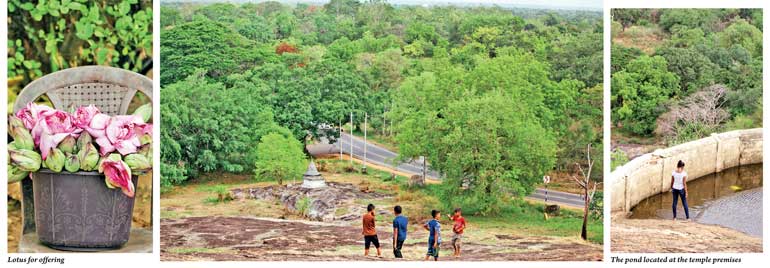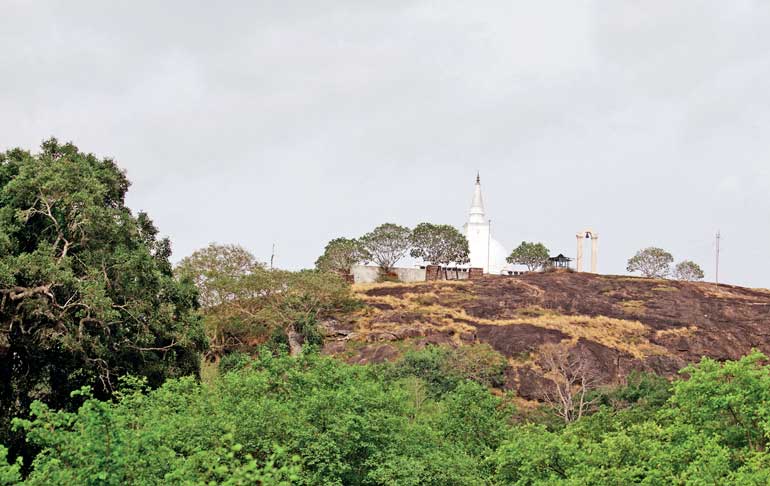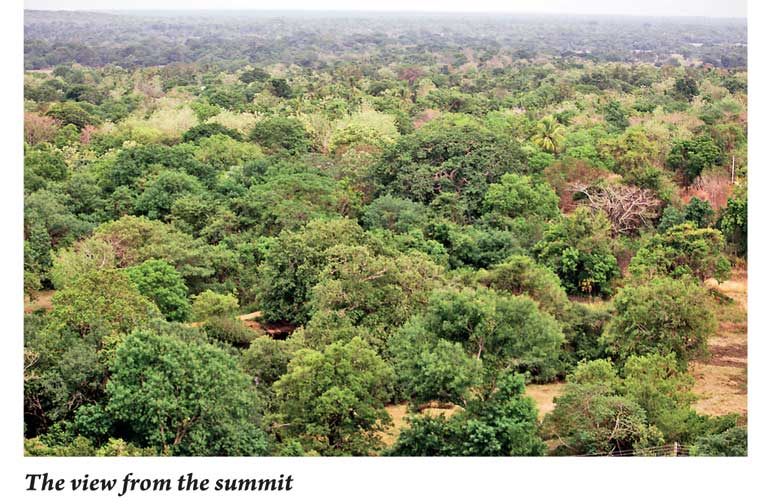Monday Mar 31, 2025
Monday Mar 31, 2025
Saturday, 12 August 2017 00:58 - - {{hitsCtrl.values.hits}}
 By Aysha Maryam Cassim
By Aysha Maryam Cassim
As you pass Anuradhapura and proceed along the A9 Road, you will reach Medawachchiya. Northbound travellers and pilgrims who travel to Anuradhapura or Mihintale often fail to notice the unspoilt beauty of this region, nurtured by a rich irrigation and Buddhist heritage.
Medawachchiya is endowed with lush vegetation, surrounded by rocky boulders, waterfronts and temples, which depict an idyllic picture of “Gamai, Dagabai, Wawai, Pansalai”.
Medawachchiya division is surrounded by Vavuniya District to the north, Kebithigollewa Division to the east, Kahatagasdigiliya Division to the south-east, Rambewa Division to the south and Nuwaragampalatha Central Division to the north-west.
Medawachchiya is one of the areas hit hardest by the drought. For nearly three decades, country’s civil war affected the social and economic conditions of locals. Villagers live with a constant fear of wild elephant attacks and make ends meet with hardship.
Apart from paddy, they cultivate black gram, green gram, maize, peanuts, onions and vegetables. When wells and reservoirs run dry and the parched earth cracks up, the only hope that the villagers have is the monsoonal rains.
What is there to see in Medawachchiya?
Isinbasinagala is a rocky boulder located approximately 2km away from Medawachchiya. The temple was built by King Dewanampiyathissa (250-210 BC), after introducing Buddhism to Sri Lanka by Arahath Mahinda Thero.
Legend has it that Arahath Mihindu Thero along with other Buddhist monks first arrived at this historical place before descending upon Mihintale. The name ‘Isinbassagala’ translates as ‘the rock on which the sage descended’. The word “isi” derives from the Sanskrit word “rishi” (The Sage).

Some critics and historians argue that it is Isinbasinagala where Lord Buddha delivered his first sermon, Dhamma Chakka Pavaththana Sutraya, after attaining enlightenment and not the site situated on the Western Bank of River Ganga, in Uttar Pradesh of India.
Halfway up the climb, you’ll find a golden statue of Lord Buddha and King Devanampiyatiisa, erected near the balustrades of the temple entrance. Ruwangiri Raja Maha Viharaya, which is perched on the top of the plateau, rewards you with panoramic view and a breathtakingly beautiful skyline.
Devotees ascend the rock along a series of steps to seek blessings and pay offerings at the temple. The stupa that you find here is constructed in the early 20th century. On this side of the rock is an ancient cave room called Arhath Guhawa where monks and hermits used to mediate.

Among the excavations unearthed from Isinbasinagala premises are Naga Gala (Cobra carved stone) and Sri Pathul Gala (Foot Print of Buddha). The naga is believed to have protected the Buddha from the elements like rain and storm after he attained enlightenment.
The concept of Naga is closely associated with symbols of Buddhism. The Naga in ancient stone inscriptions usually has the form of a great cobra, depicted with a single head but sometimes with many heads.
The Naga stone at Isinbasinagala Bo Maluwa stands as an evidence for the existence of a Naga tribal community and identity during the pre-Buddhist era of ancient Sri Lanka. The Sri Pathul Gala that was found at this site is a clear indication of its antiquity. Before the rise of Buddha statues in the 2nd century, worshippers used this slab of rock on which the foot print of Buddha is carved to represent Lord Buddha
How to get there
You can start the ascent from the white dragon entrance located at the bottom of the rock or through the gravel road from the main temple. There is another alternative route from the main road that will lead you to the temple along a gentle upward slope.
After the excursion, you can quench your thirst with a thambili or a glass of beli mal with palm sugar at the nearby shack before you continue your journey towards north or south.

Discover Kapruka, the leading online shopping platform in Sri Lanka, where you can conveniently send Gifts and Flowers to your loved ones for any event including Valentine ’s Day. Explore a wide range of popular Shopping Categories on Kapruka, including Toys, Groceries, Electronics, Birthday Cakes, Fruits, Chocolates, Flower Bouquets, Clothing, Watches, Lingerie, Gift Sets and Jewellery. Also if you’re interested in selling with Kapruka, Partner Central by Kapruka is the best solution to start with. Moreover, through Kapruka Global Shop, you can also enjoy the convenience of purchasing products from renowned platforms like Amazon and eBay and have them delivered to Sri Lanka.
Discover Kapruka, the leading online shopping platform in Sri Lanka, where you can conveniently send Gifts and Flowers to your loved ones for any event including Valentine ’s Day. Explore a wide range of popular Shopping Categories on Kapruka, including Toys, Groceries, Electronics, Birthday Cakes, Fruits, Chocolates, Flower Bouquets, Clothing, Watches, Lingerie, Gift Sets and Jewellery. Also if you’re interested in selling with Kapruka, Partner Central by Kapruka is the best solution to start with. Moreover, through Kapruka Global Shop, you can also enjoy the convenience of purchasing products from renowned platforms like Amazon and eBay and have them delivered to Sri Lanka.